
Thrust Ball Bearings
A thrust bearing is a particular type of rotary rolling-element bearing. Like other bearings they permit rotation between parts, but they are designed to support a predominately axial load. Thrust ball bearings, composed of ball bearings supported in a ring, can be used in low thrust applications where there is little axial load. Product Range 51101 – 51130, 51204 – 51228, 51305 – 51330, 51405 – 51424 Big series above 100mm bore also available in brass cage
...more
Taper Roller Bearings
The inner and outer ring raceways are segments of cones and the rollers are also made with a taper so that the conical surfaces of the raceways and the roller axes if projected, would all meet at a common point on the main axis of the bearing. This conical geometry is used as it gives a larger contact patch, which permits greater loads to be carried than with spherical (ball) bearings, while the geometry means that the tangential speeds of the surfaces of each of the rollers are the same as their raceways along the whole length of the contact patch and no differential scrubbing occurs. When a roller slides rather than rolls, it can generate wear at the roller-to-race interface, i.e. the differences in surface speeds creates a scrubbing action. Wear will degenerate the close tolerances normally held in the bearing and can lead to other problems. Much closer to pure rolling can be achieved in a tapered roller bearing and this avoids rapid wear. The rollers are guided by a flange on the inner ring. This stops the rollers from sliding out at high speed due to their momentum.
...more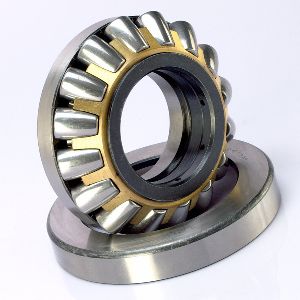
Spherical Roller Thrust Bearings
A spherical roller thrust bearing is a rolling-element bearing of thrust type that permits rotation with low friction, and permits angular misalignment. The bearing is designed to take radial loads, and heavy axial loads in one direction. Typically these bearings support a rotating shaft in the [bore] of the shaft washer that may be misaligned in respect to the housing washer. The misalignment is possible due to the spherical internal shape of the house washer
...more
Spherical Roller Bearings
A spherical roller bearing is a rolling-element bearing that permits rotation with low friction, and permits angular misalignment. Typically these bearings support a rotating shaft in the [bore] of the inner ring that may be misaligned in respect to the outer ring. The misalignment is possible due to the spherical internal shape of the outer ring Most spherical roller bearings are designed with two rows of rollers, allowing them to take very heavy radial loads and heavy axial loads. There are also designs with one row of rollers, suitable for lower radial loads and virtually no axial load. These are also called "barrel roller bearings" or "Tonnenlager" and are typically available in the 20200 and 20300 series.
...more
Self Aligning Ball Bearings
Self-aligning ball bearings, are constructed with the inner ring and ball assembly contained within an outer ring that has a spherical raceway. This construction allows the bearing to tolerate a small angular misalignment resulting from shaft or housing deflections or improper mounting. The bearing was used mainly in bearing arrangements with very long shafts, such as transmission shafts in textile factories.
...more
Pillow Block Bearings
Pillow blocks are usually referred to the housings which have a bearing fitted into them and thus the user need not purchase the bearings separately. Pillow blocks are usually mounted in cleaner environments and generally are meant for lesser loads of general industry. These differ from "plummer blocks" which are bearing housings supplied without any bearings and are usually meant for higher load ratings and corrosive industrial environments. However the terms pillow block and plummer block are used interchangeably in certain parts of the world.
...more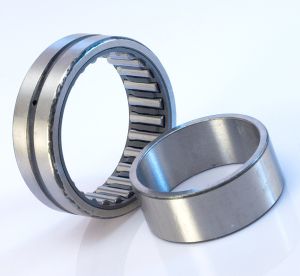
Needle Roller Bearing
A needle roller bearing is a bearing which uses small cylindrical rollers.The difference of a needle roller bearing and roller bearing is the ratio of diameter and length of their rollers, when the ratio of the diameter and the length of roller of a roller bearing is between the interval of 0.4 to 0.1, that roller bearing is called as needle roller bearing. They are used to reduce friction of a rotating surface. Needle bearings have a large surface area that is in contact with the bearing outer surfaces compared to ball bearings. Additionally there is less added clearance (difference between the diameter of the shaft and the diameter of the bearing) so they are much more compact.
...more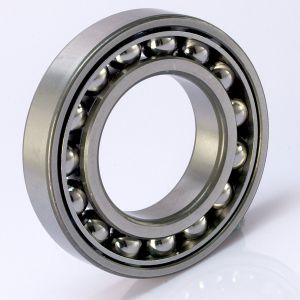
Four Point Contact Bearings
Four point contact bearings whereas a radial load takes an oblique path that tends to want to separate the races axially. So the angle of contact on the inner race is the same as that on the outer race. Angular contact bearings better support "combined loads" (loading in both the radial and axial directions) and the contact angle of the bearing should be matched to the relative proportions of each. The larger the contact angle (typically in the range 10 to 45 degrees), the higher the axial load supported, but the lower the radial load. In high speed applications, such as turbines, jet engines, and dentistry equipment, the centrifugal forces generated by the balls changes the contact angle at the inner and outer race
...more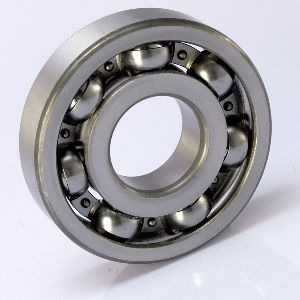
Deep Groove Ball Bearings
A ball bearing is a type of rolling-element bearing that uses balls to maintain the separation between the bearing races. The purpose of a ball bearing is to reduce rotational friction and support radial and axial loads. It achieves this by using at least two races to contain the balls and transmit the loads through the balls. In most applications, one race is stationary and the other is attached to the rotating assembly (e.g., a hub or shaft). As one of the bearing races rotates it causes the balls to rotate as well. Because the balls are rolling they have a much lower coefficient of friction than if two flat surfaces were sliding against each other. Ball bearings tend to have lower load capacity for their size than other kinds of rolling-element bearings due to the smaller contact area between the balls and races. However, they can tolerate some misalignment of the inner and outer races.
...more
Cylindrical Roller Bearings
Common roller bearings use cylinders of slightly greater length than diameter. Roller bearings typically have higher load capacity than ball bearings, but a lower capacity and higher friction under loads perpendicular to the primary supported direction. If the inner and outer races are misaligned, the bearing capacity often drops quickly compared to either a ball bearing or a spherical roller bearing
...more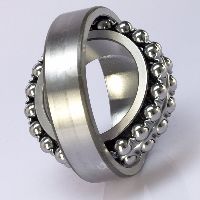
Antifriction bearing
Antifriction bearing are constructed with the inner ring and ball assembly contained within an outer ring that has a spherical raceway. This construction allows the bearing to tolerate a small angular misalignment resulting from shaft or housing deflections or improper mounting. The bearing was used mainly in bearing arrangements with very long shafts, such as transmission shafts in textile factories.
...more
Angular Contact Ball Bearings
An angular contact ball bearing uses axially asymmetric races. An axial load passes in a straight line through the bearing, whereas a radial load takes an oblique path that tends to want to separate the races axially. So the angle of contact on the inner race is the same as that on the outer race. Angular contact bearings better support "combined loads" (loading in both the radial and axial directions) and the contact angle of the bearing should be matched to the relative proportions of each. The larger the contact angle (typically in the range 10 to 45 degrees), the higher the axial load supported, but the lower the radial load. In high speed applications, such as turbines, jet engines, and dentistry equipment, the centrifugal forces generated by the balls changes the contact angle at the inner and outer race
...more
Ball Bearings

Roller Bearings

Bushes
Be first to Rate
Rate ThisOpening Hours